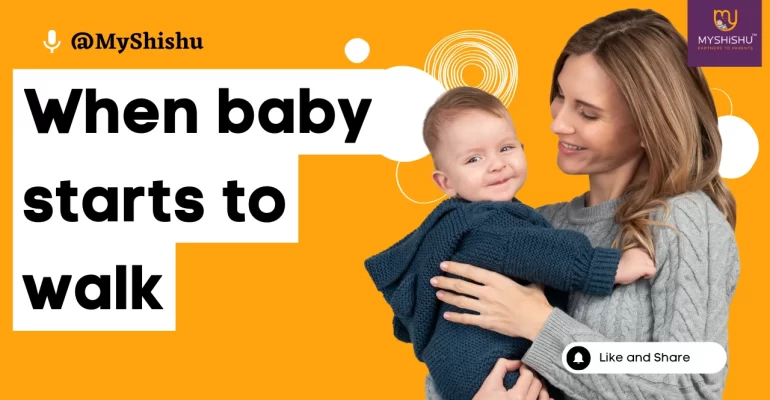When baby starts to walk
When baby starts to walk
Embarking on the adventure of your baby’s first steps is a remarkable journey filled with anticipation and joy. MyShishu is your trusted companion in understanding the intricacies of your baby’s walking milestones. Let’s delve into the stages of walking development, discover additional insights, and gain a deeper understanding of this momentous phase in your baby’s growth.
Table of Contents
- Unveiling the Walking Milestones: When baby starts to walk
- Identifying Signs of Late Walkers: When baby starts to walk
- Facilitating Your Baby’s Walking Adventure: When baby starts to walk
- Evaluating Baby Products for Walking: When baby starts to walk
- Navigating Beyond First Steps: When baby starts to walk
- Conclusion: When baby starts to walk
- Quiz: When baby starts to walk
Unveiling the Walking Milestones: When baby starts to walk
From sitting independently to those initial independent steps, your baby’s walking journey encompasses several key stages:

- 6 months: Mastering the art of sitting unaided.
- 6-9 months: Initiating the crawling phase.
- 9 months: Pulling up on furniture, a precursor to standing.
- 9-12 months: Exploring the surroundings while standing with support.
- 11-13 months: Witnessing those eagerly awaited first steps as your baby ventures into independent walking.
It’s essential to recognize that every baby’s development timeline is unique. Some may take their first steps earlier or later, and that’s perfectly normal. If you find yourself concerned about your baby’s walking progress, especially if they’re 18 months or older without walking, consulting your pediatrician is advisable.
Identifying Signs of Late Walkers: When baby starts to walk
- Fails to roll over or sit with assistance.
- Doesn’t bear any weight on their legs.
- Doesn’t attempt to attract attention through actions.
- Doesn’t engage in babbling or attempting to talk.
- Displays no interest in interactive games like peekaboo.
Facilitating Your Baby’s Walking Adventure: When baby starts to walk

- Structured Playtime: Foster a secure environment during playtime, encouraging your baby’s confidence to explore freely.
- Dynamic Movement: Assist your baby in building muscle strength by kneeling in front of them, extending your hands, and motivating them to move toward you.
- Enhanced Safety Measures: Strengthen safety precautions by securing cabinets, padding furniture corners, installing child-proof gates, and ensuring hazardous items are out of reach.
Evaluating Baby Products for Walking: When baby starts to walk
- Baby Walkers: Experts discourage the use of baby walkers due to potential developmental concerns and safety risks.
- Baby Shoes: Delay the purchase of shoes initially; allowing your baby to walk barefoot promotes enhanced balance and coordination. Introduce shoes when outdoor walking becomes a regular activity.
Navigating Beyond First Steps: When baby starts to walk
- 14 months: Standing independently, squatting, and potential backward walking.
- 15 months: Mastering walking skills, delighting in push-and-pull toys, and exploring new surroundings.
- 16 months: Developing an interest in ascending and descending stairs, seeking assistance when needed.
- 18 months: Exuding confidence in walking independently and displaying enthusiasm for climbing on furniture and dancing to music.
“It’s a good thing babies don’t give you a lot of time to think. You fall in love with them and when you realize how much they love you back, life is very simple.”
—Anita Diamant
Conclusion: When baby starts to walk
Your baby’s first steps are not just a physical achievement but the commencement of newfound independence. Savor these precious moments as your child gains confidence, navigating the world with curiosity and joy. MyShishu stands by your side, offering valuable insights to transform parenting into an informed and delightful experience.
Quiz: When baby starts to walk
- What are the typical milestones leading up to a baby’s first steps?
a) Crawling, standing, walking
b) Rolling, sitting, jumping
c) Standing, running, hopping - Why is it crucial to baby-proof your home during the walking stage?
a) To restrict a baby’s movement
b) To encourage exploration safely
c) To discourage physical activity - What additional safety measures can be taken to secure your baby’s environment during walking?
a) Installing child-proof gates
b) Padding furniture corners
c) All of the above
Answers:
- a) Crawling, standing, walking
- b) To encourage exploration safely
- c) All of the above
Celebrate each step of your child’s journey and remember that parenting is an ever-evolving adventure. Stay tuned for more insightful blogs from MyShishu!
Explore our range of courses on new-age parenting at New-Age Parenting | Modern Parenting Styles | MYSHISHU.
For additional parenting insights and valuable information, check out our blog “Cry, Feeding and Weaning of Newborn Baby” at Cry, Feeding and Weaning of Newborn Baby – My Shishu.
Hope you’ve enjoyed the blog “When baby starts to walk”. Happy Parenting!











